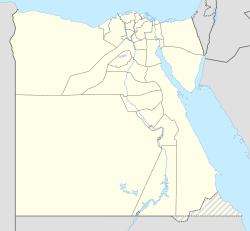Tomb of Thutmose II facts for kids
Quick facts for kids Wadi C-4 |
|
|---|---|
| Burial site of Thutmose II | |
| Coordinates | 25°44′12″N 32°34′42″E / 25.73667°N 32.57833°E |
| Location | Wadi Gabbanat el-Qurud, Western Wadis, Egypt |
| Discovered | October 2022 |
| Excavated by | Joint Egyptian-British archaeological expedition (2025) |
| Decoration | Book of the Amduat |
| Layout | Bent to the left |
The Tomb of Thutmose II is an ancient Egyptian tomb built for a pharaoh. It is located in the Wadi Gabbanat el-Qurud area, west of Luxor. This tomb is also known as Wadi C-4. It belonged to Thutmose II, a pharaoh who ruled Egypt around 16th–15th centuries BC.
Interestingly, Thutmose II's mummy was not found inside this tomb. His mummy was discovered in 1881 in a special hiding place called the Royal Cache. Many royal mummies were moved there long ago to protect them.
Archaeologists from Egypt and Britain worked together to find and identify this tomb. Ashraf Omar discovered it in 2022. The discovery was officially announced in 2023.
Contents
Discovering the Tomb
The tomb was found during a large search for ancient sites in the Western Wadis. This area is close to the Nile River in southern Egypt. The search began in October 2022. That's when the entrance and main passage of Wadi C-4 were found.
Why the Tomb Was Hard to Find
Experts believed the tomb had been sealed since the Third Intermediate Period. Over time, repeated flooding filled the main passage with thick mud. This mud became as hard as concrete. The floods also damaged the tomb's ceilings, causing parts of them to collapse.
Who Was Expected to Be Buried There?
At first, the archaeological team thought the tomb belonged to a royal wife. This was because it was near the tombs of three wives of Thutmose III. It was also close to Hatshepsut's planned burial site as a queen. It took almost three years of careful digging to confirm that a pharaoh owned the tomb.
A Special Discovery
The Egyptian Ministry of Tourism and Antiquities announced this was the first pharaoh's tomb found since Tutankhamun's tomb in 1922. However, other royal tombs had been found since then. For example, the tomb of Psusennes I was found in 1940. The tomb of Senebkay was found in 2014. Thutmose II's tomb was the first royal tomb from the New Kingdom period found since Tutankhamun's.
Tomb Design and Architecture
The tomb has a simple design. This style became common for royal tombs after Thutmose II's time. Its location near the Valley of the Kings shows how royal burial customs changed. The tomb was built with a special "bent axis" design. This means the main path turns to the left. This design became standard for later royal tombs in the Eighteenth Dynasty.
Chambers and Corridors
The tomb has three larger rooms, called A, B, and D by the archaeologists. Room C is smaller and next to room B. Room A is the largest inside room. It measures about 5.3 by 5.2 meters and is 3.4 meters high. This room was once decorated, but only small parts remain. It is believed to be the main burial chamber.
There are two corridors. Corridor 1 is the main entrance and leads to room D. Corridor 2 was added later. It starts on the west side of corridor 1 and goes to the main room A. It enters room A about 1.7 meters above the floor.
The Unusual Second Corridor
The second corridor is "unusual" because it slopes upward. Most tomb corridors slope downward. This passage also has a white gypsum plaster finish. It shows signs of being made bigger twice. Archaeologists think this second corridor was an emergency exit. It was likely used after floods blocked the original main corridor.
Condition of the Tomb
The tomb was badly damaged by floods that happened soon after Thutmose II was buried. Evidence shows that many of the tomb's original items were moved. This was done to protect them from more flood damage. Some time after his first burial, Thutmose II's body was moved to the Deir el-Bahari Cache. His mummy was found there in the 1800s.
What Was Found Inside
The tomb contained several items that proved it belonged to a pharaoh. These included alabaster jars with hieroglyphic writing. The writing showed Thutmose II's name, calling him Osiris Aakheperenre. There were also writings mentioning his sister-wife, the Great Royal Wife Hatshepsut.
This suggests that Hatshepsut oversaw his burial ceremonies. Thutmose II's son and successor, Thutmose III, was too young to do it himself. These items were the first of Thutmose II's burial belongings ever found. Archaeologists believe other items were destroyed by floods. While no complete burial goods were found, many pottery pieces in rooms B and C show that a burial did take place.
Wall Decorations
Many of the tomb's wall decorations were badly damaged. This was caused by flash floods that regularly swept through the valley. During the digging, pieces of mortar with blue writing were found. There were also yellow star designs.
The Book of the Amduat
On pieces of a yellow background, which looked like old papyrus, parts of the Amduat were discovered. The Amduat is a special ancient text. It was often found in royal tombs. It was meant to guide the pharaoh through the afterlife. The text was written in a flowing, cursive hieroglyphic style. This style was usually used for sacred texts on papyrus.
Because of this, archaeologists think the tomb's decorations looked like those in KV34. KV34 is the tomb of Thutmose II's son, Thutmose III.



